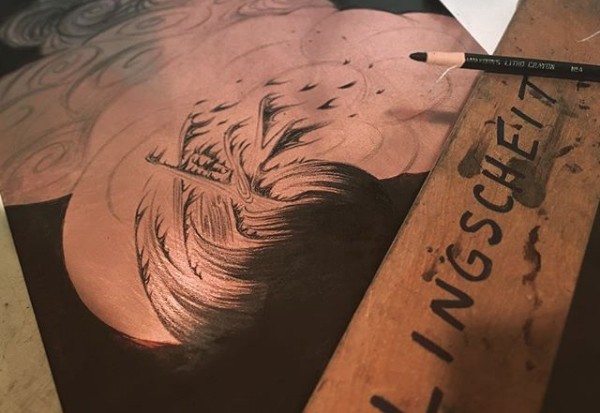Artist Statement
My intaglio prints exploit the subtleties of etching and mezzotint technique to explore themes of human behavior, social interaction, and the malleable nature of remembrance. I have long been interested in how current identity is tangled inextricably with the past. As systems of perception and memory are imperfect, our every moment is subject to omission as well as misinterpretation and embellishment by the imagination or by emotion. In turn, each subsequent recalling of an experience is vulnerable to repression, convolution, and dissipation. I am interested in the notion of physical gaps left by these absences of information, these holes within the structure of our past and present lives.
Nestled among our memories of singular moments, there also lay conflations of memory — separate remembrances morphing together like beads of moisture on glass: these half-imagined pasts that become layered among the façade of a person’s current self. My figurative imagery presents equivocal narratives that are often characterized by omission, distortion, and hyperbole. I am fascinated by small gestures, deliberate posturing, unguarded action and reaction…all of these little movements that comprise relationships among people. I believe that these images, as chronicled across copper surfaces and eventually consigned to paper impression, invite a dialogue with viewers because we all crave familiarity, endlessly longing to connect ourselves with other people through fragments and layers of shared experience.
In a world of modern technology, I am drawn to intaglio printmaking because of the directly tactile relationship it requires to both physical materials and the developing image. The matrix evolves gradually as each mark builds upon the previous, creating a physical record of past action across the metal surface in what often becomes truly a labor of love. Mistakes are not easily undone – they must be painstakingly corrected or inventively incorporated, often leading down new paths of creativity and innovation in a way that a “Control-Z” option would likely have stymied. I see the finished intaglio plate as a sculptural, visible chronicling of each decision — whether additive or subtractive — enacted over the course of making each piece. This methodology allows me to maintain a balance between careful composition and pure intuition as I explore the interplay of deliberate mark-making with experimentation and unanticipated results. The physical process of creating each plate thus parallels the vacillating, simultaneously creative and erosive qualities of memory formation and recall that are important components of my research.
